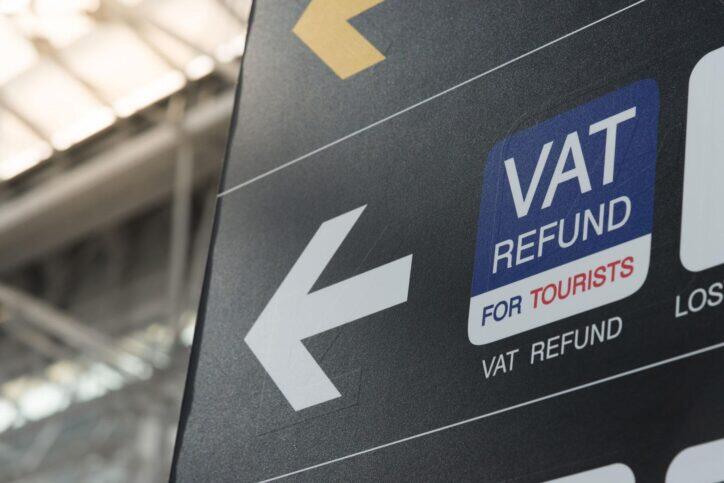Get that refund!
It’s a great time to go shopping in Europe. The value of the euro compared to the dollar is at two-decade lows, and many products made in the European Union can be gotten for cheaper across the pond than they can be in the U.S.
Goods sold in European Union countries have Value-Added Tax (VAT) included in the posted price. VAT varies from country to country, but in most E.U. member states, non-residents are entitled to a refund of the VAT paid on goods if they are exported and not consumed while in the E.U.
Because travelers have to demonstrate the goods will be exported, there are a few hoops to jump through to benefit from the tax refund. The exact process varies by country, but here are a few tips to smooth the process.
Look for the Tax-Free Sign
Most retailers that do significant business with non-E.U. residents offer tax refunds, typically through GlobalBlue or another tax refund provider. Retailers offering tax-free shopping often have a sign posted near the door, or are listed on the refund provider’s website or mobile app.
Take Your Passport
You’ll have to prove residence outside the European Union at the time of purchase. There’s a simple form to fill out with passport details and a home address. You’ll pay the full purchase price upfront. It’s easiest to pay with a credit card, as the processor will simply refund the tax back to the card once the paperwork is received.
Continue Reading Article After Our Video
Recommended Fodor’s Video
Some large department stores have dedicated desks for tax-free shopping, so customers can make their purchases in various departments and then do the tax-free forms separately.
How Much Is the Refund?
The refund amount will typically be indicated on the paperwork printed by the retailer. VAT rates vary by country, as do minimum purchases. It’s worth noting the minimum purchase is per transaction, rather than an aggregate total, so you’ll need to have the forms completed every time you make a qualifying purchase.
For example, the VAT rate in France is 20% on most goods, and the minimum purchase amount is 100 euros. In Germany, the VAT rate is 19%, but the minimum purchase is only 50 euros. The refund processor will also retain a portion of the refund to cover administrative costs, but the discount is often still worth the trouble.
Don’t Use the Goods
Qualification for a refund is incumbent upon the goods being exported from the European Union unused. In practice, Customs agents rarely verify this but it’s a good idea to resist the temptation to don those fashions or sample those treats. Keep purchases in their original wrapping until you get home, just in case you get an overzealous inspector.
Check the Paperwork
Be sure to check the refund paperwork for accuracy, and read the instructions for claiming your refund carefully—it’s usually on a page opposite the pre-addressed postage-paid envelope for mailing the forms back to the processor. Most of the forms will have detailed instructions for getting Customs validation at major airports in that country. If you’re traveling to another E.U. country, be sure to check in advance where the Customs office is at your departure airport.
The Tricky Part: The Customs Stamp
Travelers departing directly for the United States from Paris have it easy. They simply take their forms to the tax refund office at the airport, scan the barcode(s) on their paperwork, and that’s it. The forms are electronically verified and needn’t even be mailed. The refunds will appear on the credit card they used. Travelers seeking a cash refund can do so at the same kiosk, although an additional commission will sometimes be charged.
In some other countries, or for travelers making multi-country tours, it can be trickier.
The goods must be declared at Customs at your last departure point from the E.U. and it can sometimes be tricky to find the Customs office. Customs offices can be before security checkpoints, after security checkpoints, or dotted throughout the terminal.

At some airports, like Berlin Brandenburg, there are two separate Customs points—one for travelers exporting goods in checked luggage (before security) and another for travelers exporting goods in their carry-on bags (after security)—but only on flights directly departing the E.U. Travelers making connections at other E.U. airports will have to find the post-security Customs checkpoints at their gateway airport.
Some countries, like Germany and The Netherlands, are still manually stamping all tax refund forms for mailing. In France and Portugal, it’s an electronic process, but only if all your goods were purchased in that country—if you have goods from other E.U. countries, you need a manual stamp.
If you do have to deal with a Customs officer, have your passport, boarding pass, and forms available. A boarding pass is necessary because it allows the agent to verify that you’re departing the E.U. so check-in for your flight first. You’ll also need to have the goods available to show the agent, although they normally just ask if the goods are in your possession and rarely ask to inspect them—but that doesn’t mean they won’t.
Cash Refunds
Cash transactions will qualify for cash refunds. Refunds are either paid in euros at airport kiosks (some offer to pay in other currencies, generally at an unfavorable exchange), or via a paper check mailed from the refund office once mailed-in paperwork is received. In either case, the hassle of dealing with foreign currency or foreign checks is something to consider when making large purchases in cash.
Weird Situations
Most U.S. travelers will be departing the E.U. at an airport, where the process is straightforward. There are some exceptions, however. Travelers departing the E.U. to non-member states such as the United Kingdom, Norway, or Switzerland can get their forms stamped at railway stations, ferry terminals, and border crossing checkpoints. At any of these, be sure to look for the tax-free or Customs signs.
Another consideration is that not all E.U. member states use the euro as their currency, so if you’re departing from a country that doesn’t use the euro (like Sweden) cash purchases may be subject to a conversion from euros to the local currency (or vice versa) at an unfavorable exchange. In either case, if you’re traveling with multiple purchases in different currencies, allow some extra time.
All it takes is a little extra research and perhaps some extra steps, but shopping tax-free in Europe is a highlight for many travelers.

